
Calf of Man is a 2.50-square-kilometre (618-acre) island, off the southwest coast of the Isle of Man. It is separated from the Isle of Man by a narrow stretch of water called the Calf Sound. Like the nearby rocky islets of Chicken Rock and Kitterland, it is part of the historic parish of Rushen and the current parish district of Arbory and Rushen. It has only two seasonal inhabitants. The word 'calf' derives from the Old Norse word kalfr which means a small island lying near a larger one. One can reach the Calf of Man by boat from either Port Erin or Port St Mary. Cow Harbour and South Harbour are the main landing places. The highest part of the island is in the west where an unnamed peak reaches 126 m (415 ft) above sea level.

Douglas is the capital and largest town of the Isle of Man, with a population of 26,677 (2021). It is located at the mouth of the River Douglas, and on a sweeping bay of two miles. The River Douglas forms part of the town's harbour and main commercial port.

Isle of Whithorn is one of the most southerly villages and seaports in Scotland, lying on the coast north east of Burrow Head, about three miles from Whithorn and about thirteen miles south of Wigtown in Dumfries and Galloway. Whithorn,, is a former royal burgh in Wigtownshire, Dumfries and Galloway, with which Isle of Whithorn is frequently incorrectly amalgamated or confused. It is referred to locally as 'The Isle' - never 'the Isle of Whithorn'.

Castletown is a town in the Isle of Man, geographically within the historical parish of Malew but administered separately. Lying at the south of the island, it was the Manx capital until 1869. The centre of town is dominated by Castle Rushen, a well-preserved medieval castle, originally built for a Viking king.

Laxey is a village on the east coast of the Isle of Man. Its name derives from the Old Norse Laxa meaning 'Salmon River'. Its key distinguishing features are its three working vintage railways and the largest working waterwheel in the world. It is also the location of King Orry's Grave.

Peel is a seaside town and small fishing port in the Isle of Man, in the historic parish of German but administered separately. Peel is the third largest town in the island after Douglas and Ramsey but the fourth largest settlement, as Onchan has the second largest population but is classified as a village. Until 2016 Peel was also a House of Keys constituency, electing one Member of the House of Keys (MHK), who, from September 2015, was Ray Harmer. Peel has a ruined castle on St Patrick's Isle, and a cathedral, seat of the Diocese of Sodor and Man.

Port Erin is a seaside village in the south-west of the Isle of Man, in the historic parish of Rushen. It was previously a seaside resort before the decline of the tourist trade. Administratively it is designated as a village district, with its own board of commissioners. The district covers around 1 square mile, and is adjacent to: Port St Mary to the south-east; the main part of Arbory and Rushen parish district to the north and east; the sea to the west; and an exclave of Arbory and Rushen parish district to the south. Following recent residential expansion, the settlement is now contiguous with that of Port St Mary, and on 18 July 2018 Tynwald authorised a public enquiry into the proposed expansion of the district boundary to include some of this expansion.
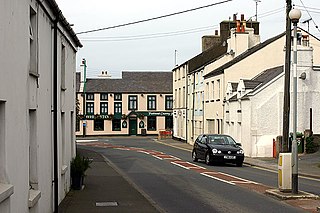
Ballasalla is a village in the parish of Malew in the south-east of the Isle of Man. The village is situated close to the Isle of Man Airport and 2 miles (3 km) north-east of the town of Castletown.

Ballabeg is a village on the Isle of Man. It is in the parish of Arbory in the sheading of Rushen, in the south of the island near Castletown. There are several small villages and hamlets with the name, although Ballabeg in Arbory is the most well-known and populous.
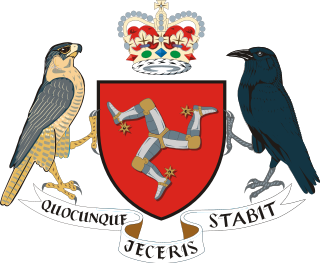
Local governmentin the Isle of Man was formerly based on six sheadings, which were divided into seventeen parishes. The island is today divided for local government purposes into town districts, village districts, parish districts, and "districts", as follows:

Rushen, formally Kirk Christ Rushen, is one of the seventeen historic parishes of the Isle of Man.
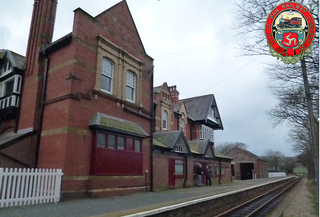
Port St Mary Railway Station is a station in Port St Mary in the south of the Isle of Man and is served by the Isle of Man Railway, having first opened in 1874 when the line to nearby Port Erin was completed. It forms part of the sole remaining section of the railway which once covered a network of some 46 miles across the island.
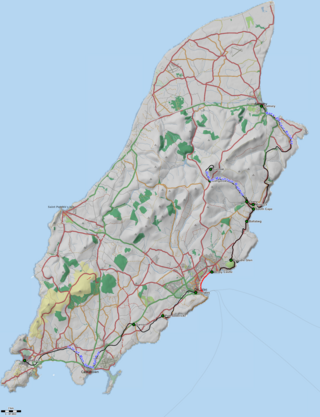
The Isle of Man has a rich transport heritage and boasts the largest narrow-gauge railway network in the British Isles with several historic railways and tramways still in operation. These operate largely to what is known as "Manx Standard Gauge" and together they comprise about 65 miles (105 km) of Victorian railways and tramways. The Isle of Man Railway Museum in Port Erin allows people to find out more about the history of the Manx railways, and was until 1998 accompanied by a similar museum in Ramsey, which was dedicated to the history of the electric line, but this was closed and converted into a youth club. The steam railway to the south of the island, electric to the north and mountain line to the summit of Snaefell, the island's only mountain, are all government-owned, and operated under the title Isle of Man Railways, as a division of the island's Department of Infrastructure. The lines at Groudle Glen and Curraghs Wildlife Park are both privately owned but open to the public.
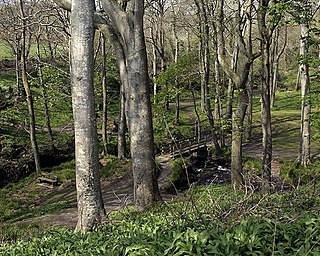
Colby is a small village in the south of the Isle of Man in the parish of Arbory. It lies on the A7 road between the towns of Castletown and Port Erin and close to the similarly sized village of Ballabeg.

The following outline is provided as an overview of and topical guide to the Isle of Man:
Port-Ny-Ding is a small bay at grid reference 188708, about 1 km north-west of Bradda West on the Isle of Man. According to the map, it can probably be seen from Raad ny Foillan. The bay is in Rushen parish district and the closest village is Port Erin.

Douglas Harbour is located near Douglas Head at the southern end of Douglas, the capital of the Isle of Man. It is the island's main commercial shipping port. The Port of Douglas was the first in the world to be equipped with radar.

Ballakilpheric is a small village in the parish of Rushen in the southwest of the Isle of Man, 1 kilometre (0.6 mi) northwest of the larger village of Colby, and 8 kilometres (5 mi) by road northeast of Port Erin. It is the main settlement on the B44 road. The small Colby River flows to the east of the village, and forms the boundary with Arbory parish. Ballakilpheric Methodist Chapel lies at the top of the hill.





















